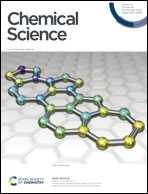Novel lanthanide nanoparticle frameworks for highly efficient photoluminescence and hypersensitive detection†
Abstract
Despite the excellent luminescent properties of lanthanide clusters (LnCs), their suprastructures that inherit their characteristic luminescent properties are scarcely reported. Herein, novel and highly luminescent suprastructures are synthesized via a two-step assembly method to incorporate LnCs in covalent organic frameworks (COFs). COFs are pre-synthesized and decorated with rigid anchoring groups on their nanochannel walls, which provide one-dimensional confined spaces for the subsequent in situ assembly of luminescent LnCs. The confined LnCs are termed nanoparticles (NPs) to distinguish them from the pure LnCs. Secondary micropores with predictable sizes are successfully formed between the walls of the nanochannels and the orderly aligned NPs therein. By using a small organic ligand that can efficiently sensitize Ln(III) cations in the assembly processes, the obtained composites show high quantum yields above 20%. The fluorescence can even be effectively maintained across nine pH units. The secondary micropores further enable the unambiguous discrimination of six methinehalides and ultrasensitive detection of uranyl ions. This study provides a new type of luminescent material that has potential for sensing and light emitting.



 Please wait while we load your content...
Please wait while we load your content...